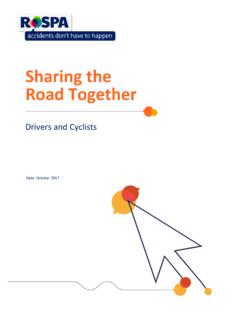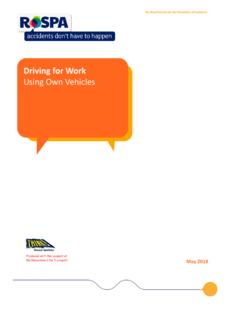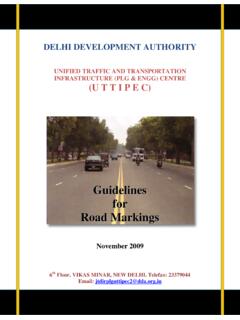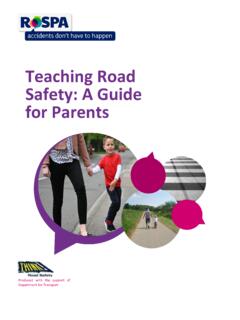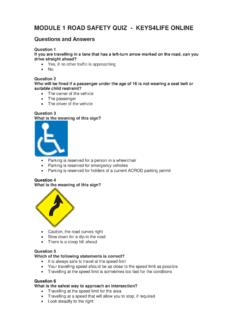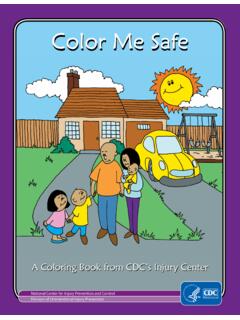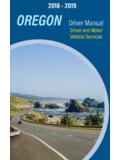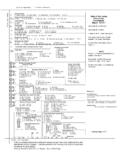Transcription of 20mph Zones and Speed Limits Factsheet - January 2020 - …
1 28 Calthorpe road , Edgbaston, Birmingham B15 1RP | Telephone 0121 248 2000 Registered Charity No: 207823 | The Royal Society for the Prevention of accidents road Safety Factsheet : 20mph Zones and Speed Limits November 2020 20mph Zones and Speed Limits Factsheet In 2019, 817 people were killed, 20,885 were seriously injured, and 91,153 were slightly injured in reported road collisions on built up* roads in Great Britain1**. A large proportion of these collisions occurred on residential roads, with 121 deaths on B roads in built-up areas and 280 deaths on other minor roads in built-up areas2. Speed significantly increases the chance of being injured in a collision. Research has shown that the risk of death for pedestrians struck by cars increases at higher impact speeds, although the exact risk levels varied between the studies.
2 One of the first studies of pedestrian injury and car impact speed3 found that at 20mph there was a chance of being fatally injured, compared to a 20% chance at 30mph, although this study is now regarded as having overestimated the risks. A recent review identified the studies which had produced the most reliable modern estimates4. *According to the DfT s definition of built-up roads. road Safety Factsheet 28 Calthorpe road , Edgbaston, Birmingham B15 1RP | Telephone 0121 248 2000 Registered Charity No: 207823 | The Royal Society for the Prevention of accidents road Safety Factsheet : 20mph Zones and Speed Limits History of 20mph Speed Limits in the UK In December 1990 the Department of Transport issued Circular Roads 4/90 which set out guidelines for the introduction of 20mph Speed Limits ; local authorities had to apply for consent from the Secretary of State to introduce a 20mph zone.
3 The initiative was based on experience internationally, which had demonstrated that lower Speed Limits could have safety benefits when combined with traffic calming measures to ensure that vehicles maintained low speeds through the zone. road safety publicity messages at the time, such as the Kill Your Speed , Not a Child campaign highlighted 20mph speeds as crucial to reducing the risks of injury in an accident . The first 20mph limit was in Tinsley, Sheffield on the junction between Raby Street and Sheffield road . Kingston upon Thames and Norwich introduced 20mph Zones shortly after. There were 450 20mph Speed Limits introduced between 1991 and 1999. In 1999, the law was changed by the road Traffic Regulation Act (Amendment) Order 1999, which gave Highways Authorities more flexibility so they no longer had to apply for permission to introduce a zone.
4 The updated legislation made two distinct types of 20mph Speed limit possible: 20mph Limits , which consist of just a Speed limit change to 20mph which is indicated by the Speed limit (and repeater) signs, and 20mph Zones , which were designed to be self-enforcing due to the traffic calming measures that were introduced along with the change in the Speed limit. It, therefore, suggests that 20mph Limits are appropriate for roads where average speeds are already low (below 24mph) or along with traffic calming measures. Ultimately the Local Authority is responsible for deciding which of these was the most appropriate. In January 2015, the Scottish Government published their Good Practice Guide in relation to the setting of 20mph Speed restrictions (updated 2016). The document aims to provide greater clarity on the options available to local authorities in setting 20 mph Speed restrictions throughout Scotland.
5 Whilst encouraging consistency across the country, local authorities have options to introduce them near schools, in residential areas and in other areas of our towns and cities where there is a significant volume of pedestrian or cyclist activity. It also aims to encourage local authorities to set 20 mph Speed restrictions, where appropriate. Local authorities have a number of options when considering introducing a 20 mph Speed restriction, including: 20 mph Speed limit Zones 20 mph Limits Variable and part-time 20 mph Limits 28 Calthorpe road , Edgbaston, Birmingham B15 1RP | Telephone 0121 248 2000 Registered Charity No: 207823 | The Royal Society for the Prevention of accidents road Safety Factsheet : 20mph Zones and Speed Limits However, the information in the Good Practice Guide is intended as guidance only.
6 It is not meant to modify or override any of the provisions contained in the relevant road traffic legislation. The guidance should not be used in isolation, but read in conjunction with the more comprehensive advice on these matters set out in the relevant legislation and guidance, including the Traffic Signs Regulations and General Directions 2016 (SI2016/362), DfT Circular 01/16 on the 2016 TSRGD, the Traffic Signs Manual and related Traffic Advisory Leaflets. The Guide is intended for use by Scottish Local Authorities and replaces all previous guidance on 20 mph issued by the Scottish Executive including SODD Circular 13/1999; 2001 SEDD Circular ; ETLLD Circular No. 1 /2004 (relating to schools) and Section of ETLLD Circular 5. The Department for Transport s current guidance is set out in DfT Circular 01/2013, which encourages traffic authorities to consider the introduction of more 20mph Limits and Zones , over time, in urban areas and built-up village streets that are primarily residential to ensure greater safety for cyclists and pedestrians6.
7 The guidance sets out that the purpose of 20mph areas is to create conditions in which drivers naturally drive at around 20mph as a result of traffic calming measures or the general nature of the location. Characteristics of 20mph Zones and Speed Limits There is a significant difference between the characteristics of a 20mph Speed limit and a 20mph zone. 20mph Limits are areas where the Speed limit has been reduced to 20mph but there are no physical measures to reduce vehicle speeds within the area. Drivers are alerted to the Speed limit with 20mph Speed limit repeater signs. 20mph Limits are most appropriate for roads where average speeds are already low, and the guidance suggests below 24mph. The layout and use of the road must also give the clear impression that a 20mph Speed or below is the most appropriate.
8 20mph Zones use traffic calming measures to reduce the adverse impact of motor vehicles on built up areas. The principle is that the traffic calming slows vehicles down to speeds below the limit, and in this way the zone becomes self-enforcing . Speed humps, chicanes, road narrowing, planting and other measures can be introduced to both physically and visually reinforce the nature of the road . Traffic calming programmes can incorporate a wide range of measures designed to work in partnership to reduce speeds and improve the overall environment, and in effect this means there can be significant differences between schemes. There are four main techniques to traffic calming programmes: Vertical deflections Horizontal deflections road narrowing Central islands 28 Calthorpe road , Edgbaston, Birmingham B15 1RP | Telephone 0121 248 2000 Registered Charity No: 207823 | The Royal Society for the Prevention of accidents road Safety Factsheet : 20mph Zones and Speed Limits Vertical deflections in the carriageway are the most effective and reliable of the Speed reduction measures currently available.
9 There are several different techniques available to achieve this: road hump Plateau ( Speed table) Cushion Uneven road surface (rumble strips) Horizontal deflections in the carriageway are less effective than vertical ones in achieving reductions in Speed , although their impact is significantly increased when used in combination with a vertical measure. Essentially all horizontal shifts may be classified as chicanes. The impact of chicanes is reduced if the design has to allow for the passage of HGVs as the wider carriageway increases the Speed that it can be negotiated at. Chicanes can significantly reduce parking spaces. road narrowing can also be used to support vertical deflections. It is not a Speed -reducing device in itself, but it can be a reminder or encouragement to drive slowly or calmly.
10 The effectiveness of this measure in controlling Speed can be increased if the carriageway width is reduced to a single lane. However, this is largely dependent on the balance of the opposing traffic flows. The extra space created by road narrowing can be used to provide some combination of widened footways, dedicated cycle lanes and formalised parking bays, or to provide more space for public transport, for example, bus lanes. Central islands have only a limited effect on reducing speeds unless combined with another measure such as a chicane. They do, however, provide useful pedestrian refuges. Often, traffic calming involves providing more space for pedestrians and cyclists, and improving the local environment. Traffic calming schemes operate on a principle of shared space between all road users.


